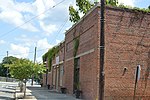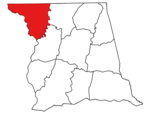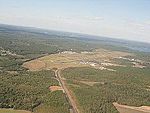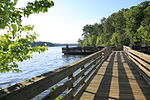Narrows Dam and Power Plant Complex
Buildings and structures in Stanly County, North CarolinaCentral North Carolina Registered Historic Place stubsDams on the National Register of Historic Places in North CarolinaHistoric districts on the National Register of Historic Places in North CarolinaIndustrial buildings and structures on the National Register of Historic Places in North Carolina ... and 3 more
NRHP infobox with nocatNational Register of Historic Places in Stanly County, North CarolinaUse mdy dates from August 2023

Narrows Dam and Power Plant Complex is a national historic district located at Badin, Stanly County, North Carolina. The district encompasses one contributing building and two contributing structures in the company town of Badin. The dam and power plant were built in 1917 by Alcoa to support the Badin plant. At the time of its completion, the Narrows Dam was the world's highest overflow type dam. The Narrows power plant is a one-story building nine bays wide with a gable roof and six-foot raised monitor roof.It was added to the National Register of Historic Places in 1983.
Excerpt from the Wikipedia article Narrows Dam and Power Plant Complex (License: CC BY-SA 3.0, Authors, Images).Narrows Dam and Power Plant Complex
576 - Moccasin Creek Road,
Geographical coordinates (GPS) Address Nearby Places Show on map
Geographical coordinates (GPS)
| Latitude | Longitude |
|---|---|
| N 35.418611111111 ° | E -80.0925 ° |
Address
576 - Moccasin Creek Road
28009
North Carolina, United States
Open on Google Maps








